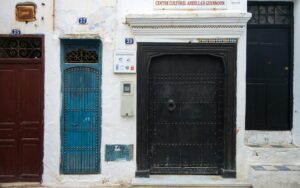Transformation of Tangier: Gritty City to Modern Metropolis
By Nicole Figueiredo – Epic’s Head of Development
I already knew a lot about Tangier, not from city guides, or by reading reviews… no, I first met Tangier thanks to art, music and books, I travelled around the city through the eyes of others. And it’s no surprise, there’s something about Tangier that inspires people.
But before I tell this story, we have to go back before my time. During the Second World War the city was a place for the rich and eccentric, inspiring the stories I read about in books. Soon after, the city fell into its role as a malnourished daughter of a busy port. Closed markets and stores, dirt roads, and dangerous corners. A place written about “for the infamous, for cabarets and for rowdy men and harassment”. This is what I knew about Tangier.
If the city had a rough and disorderly quality, there was something equally mysterious and magnetic in its diversity that attracted me and others. So, to satisfy my curiosity, I travelled there to draw my own conclusions.
That was when I really discovered the magic of Tangier.


Tangier in the 21st century
King Mohammed VI recently invested in Tangier’s growth and created an urban redevelopment program that transformed the city in just over a decade. Tangier quickly went from trash to treasure. Harassment gave way to families and young couples. The old town began to attract artists and western tourists, hungry for a different experience to the overcrowded Marrakech.
Tangier regained its creative confidence and gave birth to an exciting scene with cool young businesses giving the ancient city a dynamic feel.
Tangier it’s not like the other Moroccan cities. There’s a unique quality to it, an element that connects the city to the country but at the same time distinguishes it.
It is the product of a port city that opens its doors to Africa but also invites you to connect with Europe, located just 12 kilometres (7.5 miles) from Spain. Perhaps this mixture of two continents and the collision of East and West cultures is the source of so much of Tangier’s magic. The abundance of noises, colours, flavours and contrasts.
One day in Tangier
The person who introduced me to all of this for the first time is Tim, one of the expats who fell in love with Tangier. Here he created the Blue Door, an immersive cooking school that connects travellers with an all-female team of chefs and home cooks.
Together, early in the morning, we set off to explore the alleys winding along the slopes of a limestone hill, surrounded by 16th-century ramps. For someone used to the tumultuous confusion of other Moroccan cities, Tangier was an intriguing place for me.
The smell of the fruit on display, mixed with colourful spices, was followed by the distinctive smell of fresh fish and familiar shouting in the market. Finally, I saw proof that the city was really part of this country, after all Moroccans are excellent negotiators by nature.
A progressive city where old makes way for the new
Back at the market, we collected ingredients to cook a traditional seafood tagine. After doing a little shopping for our meal, we wandered past a traditional farram, the community oven found in every Moroccan town. But something was curious: just opposite the farram, run by another local, was an electric community oven. The contrast was evident. Tangier is a city open to change, where tradition was making room for the new.
This contrast makes itself known throughout the city. We crossed the cemetery and arrived at the Cinéma Rif, with its original art deco façade. Inside hid a café and a workspace where hip people could be found tapping away on Macbook computers while posing with vintage posters. Side by side, all over the city, old and new is found hand in hand. After sitting on this thought, the sound of Tim’s voice shouting “this way” brought us back to Earth and we headed for our class.
Connecting to Tangier through food
At the cooking school, local women shared with us their stories of Tangier and how the city had transformed not only itself but also them. A 2022 report from Morocco’s High Commission for Planning showed 8 in 10 women were not part of the workforce. Yet here in Tangier they found an open and progressive city, and a place of opportunity that accepts diversity and offers independence.
Between bites and a sip of tea, Ouassima El-Ouadi, our teacher, taught me that Tangier had two meanings: “The Hilly City” and “The Bride of the North” — which I much prefer. If Tangier was the beautiful bride, we were the glowing groom, completely under her spell. so Eager to explore more, we kept walking!


Open hearts, open minds
Stepping out onto the streets again, it was already afternoon when we met a new guide. Abderrhamane is a smiley man who loves to teach and share stories, perhaps because he came from a very big family of 14 brothers and sisters, something that is fairly common in Morocco. He is extremely passionate about Tangier and was about to show us why.
Silence encroached on our walk, as we ventured from the loud marketplace toward a remote corner not so far from the city centre. Close by, the sound of music drifted out of a very small door. We paused to peep inside and gazed in awe.
A man played an elhajuj instrument while another began to sing, his name was Bilal. It was a beautiful, spontaneous moment that only those who allow themselves to get lost in the city can hope for.


But Tangier would provide us with another genuine musical moment. On the way to our next stop, we passed a funeral. Bilal’s music faded away as a chorus of voices sung out while respectfully carrying a coffin through the streets of the city. “We are not sad with death, we accept it as God’s will”, said Abderrhamane. The memorial was sad, but also powerful and beautiful at the same time. We paid our respects and continued walking in the opposite direction
We were now in the heart of the old town, but it looked anything but old. Tiny trendy coffee shops were everywhere. The seductive cafe culture was complimented by slow fashion boutiques, designers, and art galleries. Nothing seemed traditional, apart from the narrow width of the streets.
Suddenly, something caught my eye – I’ve been to many different medinas in Morocco but I’d never seen anything as unusual as a vinyl record store, sat right there, with pink neon lights, in the middle of the kasbah. “This must be the place” the glowing neon read, my head nodded in agreement. This was just another sign confirming that Tangier isn’t an ordinary city.
Hamza Sbai and Omar Mahfoudi are the owners of Tangier Records. Although I think they’re super progressive, they don’t consider themselves pioneers. The shop is a way of contributing to the general cultural feel of the city.
“We’re giving access to culture,” said Hamza, which is perhaps why people generally feel so comfortable in this city. “They come to visit and end up living here”. Bingo!
Two faces to this diverse Moroccan city
At once Tangier was Morocco again, with traders, vendors, selling colourful clothes, shoes, spices… you name it. We were back in the thick of it where artisans could be found sewing, shaping, sculpting and more.
Tangier is just like all the books I have read. Mysterious. Magical. Real. Yet at the same time, the city has transformed, becoming a modern and progressive place while still retaining its undeniable charm. It is a city open to many cultures, genders, ethnicities and religions. A modern metropolis with an open door, where no one needs to knock.


The day felt like time had shifted into slow motion. Instead of fighting it, I let myself be guided – not by a tour but by the rhythm of this enticing city. I let the city both dominate and embrace me. Listening to every sound, soaking up every corner, and tasting everything in sight. At this moment Tangier felt electric. I felt it with every sense, and I fell in love.
Now I finally understood why so many artists had decided to make this place their home: Paul Bowles, Hendrix, Mohammed Choukri, Delacroix, Kerouac, Tennessee Williams, Patti Smith, Francis Bacon, Matisse and… me? Well, I wasn’t planning to move here but I couldn’t wait for Day Two – there were plenty more reasons to linger in Tangier.


How to reach Tangier
Ferries from Tarifa, Spain, to Tangier
Tangier is the gateway between Morocco and Europe, set at the point closest to Spain. If you’ve ever loved the idea of crossing continents by boat, plan to take the ferry from Tarifa to Tangier and cruise across to Africa. You can also board a longer ferry from Barcelona.
Fly to Tangier-Ibn Battouta International Airport
Tangier’s airport is well connected with both the rest of Morocco and Europe. Dozens of flights leave daily, jetting off to Germany, France, Spain, Portugal, the UK, the Netherlands and more.
Nicole Figueiredo – Head of Development
I am a curious and observant person. I always wonder about people and things and I want to know the why and how behind everything. I try to keep an open eye, even when seeing something that could be considered unattractive to others people. For me, everything can be interpreted as a signal that the city or people are giving you – you just need to be present, pay attention and know how to read it. That’s what attracts me to the world of travel – you are always present!

Want to explore Tangier yourself? Get in touch with our team and we’ll design and curate your dream Moroccan trip.
Latest Blogs
- Local’s Guide To Comporta: Portugal’s Coolest Beach TownComporta is one of Portugal’s most inconspicuous gems, where the elite go to be unseen and bask in the lazy, unhurried lifestyle underneath the southern sun.
- Transformation of Tangier: Gritty City to Modern MetropolisOver the past decade Tangier has gone from trash to treasure. Epic’s Nicole shares a first-hand account of her visit to the Moroccan city.
- Motorcycle Diaries: An Epic Ride From the Douro Valley to the AlentejoLast year Epic organised a brilliant family trip, taking three generations on a motorbike journey across Portugal.
- Being More – The Art of Travel Planning, Giulia PastorelliTravel Planner and Concierge Giulia tells us what brought her to epic and what she loves about Morocco



